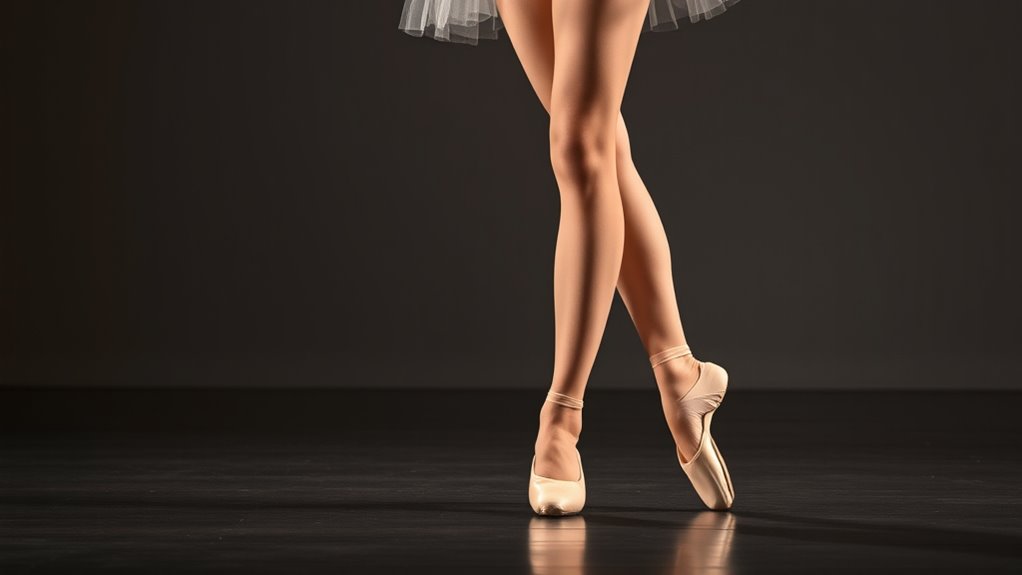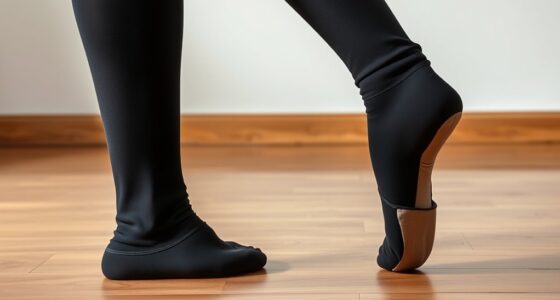To match dance tights to your skin tone on stage, start by understanding your skin’s undertone—warm, cool, or neutral—as this guides your color choice. Opt for sheer tights that blend seamlessly or opaque pairs for full coverage, and test colors in natural lighting. Consider stage lighting and background, which can affect how tights look under the spotlight. For more tips, you’ll find helpful insights to perfect your look and boost your confidence.
Key Takeaways
- Match tights to skin undertones (warm, cool, neutral) for seamless blending and a natural appearance on stage.
- Test tights under stage lighting to ensure true color harmony with your skin tone.
- Choose sheer tights for a subtle, skin-like look or opaque tights for full coverage, depending on desired stage impact.
- Consider fabric finish (matte or shiny) to complement your skin tone and costume for a cohesive look.
- Select shades that either match or subtly contrast your skin tone to enhance movement and stage presence.
Understanding Different Skin Tones and Undertones

Understanding your skin tone and undertone is essential when choosing dance tights that look natural and seamless. Your skin tone contrast, whether high or low, affects how tights blend or stand out on stage. Knowing your undertone—warm, cool, or neutral—helps you select tights that create undertone harmony, ensuring your look appears balanced and polished. If you have a warm undertone, opt for tights with a slight yellow or golden hue. Cool undertones pair better with tights that have bluish or pinkish undertones. Recognizing these subtle differences allows you to avoid mismatched shades that can make your legs appear uneven or unnatural. By understanding your skin tone contrast and undertone harmony, you’ll pick tights that enhance your appearance and feel confident during performances.
Choosing the Right Color Palette for Your Skin
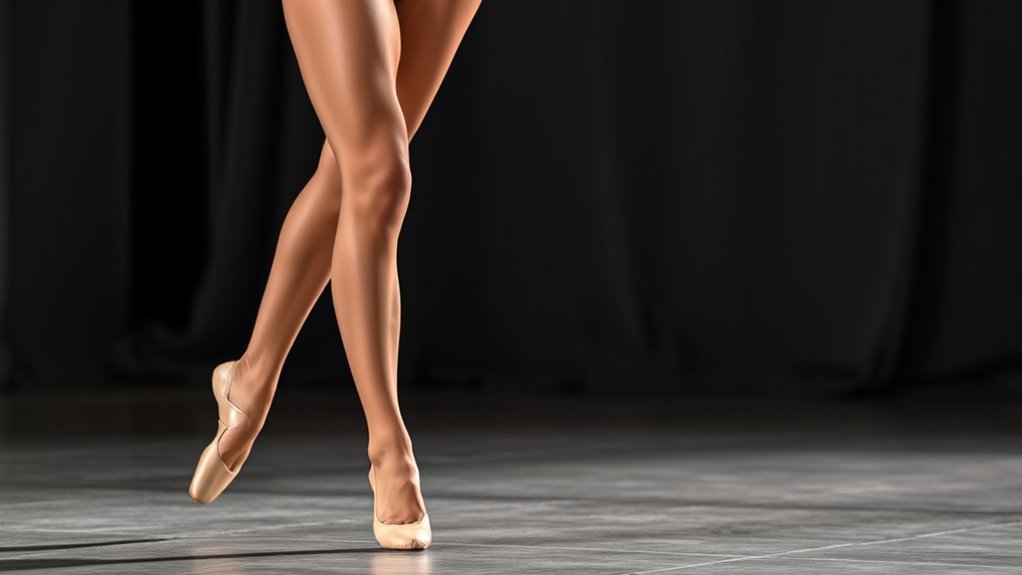
Selecting the right color palette for your skin guarantees your dance tights complement your natural look and enhance your stage presence. When it comes to color matching, focus on shades that blend seamlessly with your skin tone, creating a unified, polished appearance. Tights selection should prioritize hues that either match your skin tone closely or subtly contrast to define your lines without overpowering your performance. Consider your undertones—warm, cool, or neutral—and choose colors that enhance these nuances. Avoid overly bright or stark shades that can distract from your movement. Instead, opt for shades that harmonize with your complexion, helping you look natural and confident on stage. Understanding skin tone matching techniques can further refine your choices and ensure a cohesive visual effect. Proper color matching makes your performance visually cohesive and elevates your overall aesthetic.
The Importance of Sheer and Opaque Tights
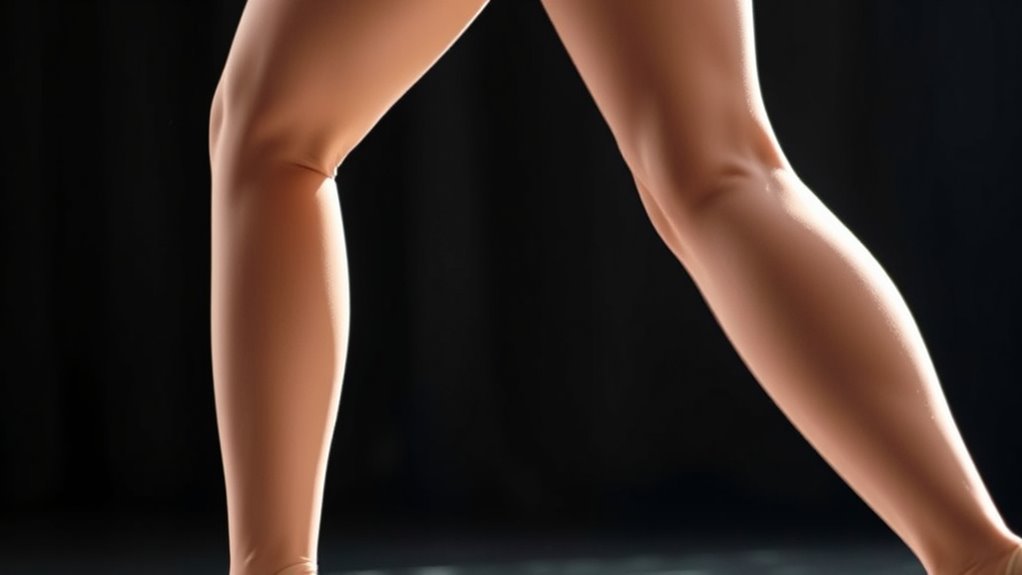
Choosing between sheer and opaque tights can markedly impact your overall stage look and movement. Sheer tights create a seamless, natural appearance that enhances your skin tone and allows for better fabric breathability, keeping you comfortable during performances. They’re also generally more delicate, so consider tights durability when choosing sheer options. Opaque tights, on the other hand, provide fuller coverage, hiding imperfections and adding a bold visual element to your costume. They tend to be thicker, offering extra warmth and support, but may feel less breathable. Your choice depends on your performance needs—sheer tights for a subtle, lightweight feel, or opaque for durability and more coverage. Either way, selecting the right type ensures your stage presence remains confident and comfortable. Additionally, selecting appropriate tights materials can help improve durability and comfort during long performances.
Factors to Consider: Lighting and Stage Environment
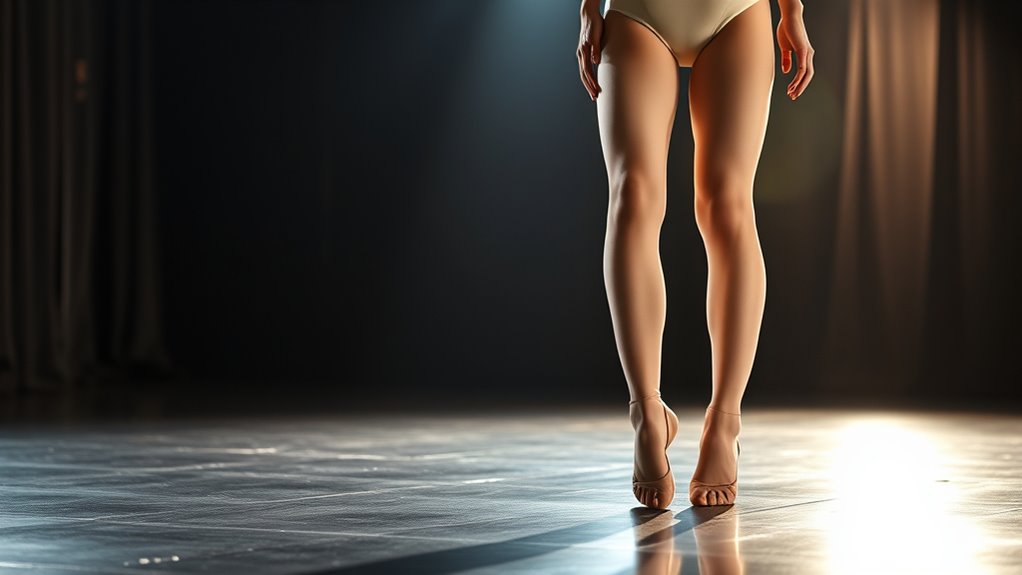
Lighting and stage environment can profoundly influence how your tights appear under different conditions. Stage lighting, especially its intensity and color, can wash out or enhance your skin-tone match. Background colors also affect visibility; darker backgrounds may require a closer skin-tone match for seamless blending. When considering these factors:
- Bright or colored stage lighting can distort your natural skin tone
- Harsh lighting might highlight differences in tights and skin
- Soft or neutral lighting helps achieve a more accurate match
- Contrasting background colors can make tights stand out or blend in
- Adjusting tights based on stage environment ensures a flawless look
- Being aware of stage lighting effects helps you select tights that complement your skin tone, creating a polished performance.
- Understanding lighting conditions allows performers to adapt their costume choices for optimal visual harmony.
- Considering stage environment factors can help tailor your costume choices to ensure a consistent and professional appearance under varying conditions.
- Awareness of lighting design can assist in planning costume selections that remain effective across different performances.
Tips for Testing and Matching Tights Before Performance

Before your performance, make certain to test your tights by comparing them to your skin in natural light. Conduct skin tone tests to find the closest match and avoid visible gaps. This process can help you ensure your tights blend seamlessly and look polished on stage. Additionally, understanding your skin tone classification can assist in selecting the most complementary tights for your complexion. For optimal results, consider installation guidelines for accessories or additional costume elements to complete your look. Familiarizing yourself with Gold IRA rollovers can also provide insights into diversifying your costume accessories for a more secure performance wardrobe.
Conduct Skin Tone Tests
To guarantee your tights match your skin tone perfectly, start by testing them in natural light, which reveals true color without distortions. When evaluating, consider how different fabric textures can affect the appearance—shiny fabrics may reflect light, making colors look different, while matte finishes provide a more accurate match. Be aware of manufacturing processes that can influence color consistency and durability, as some tights may fade or change hue over time. To ensure a perfect match, test various shades on your skin, checking for seamless blending. Remember, subtle differences in tone can be crucial on stage. Additionally, understanding how fabric finishes can impact the overall appearance and durability of tights can help you select options that maintain their color and look through performances. Moreover, awareness of automation in business can inspire manufacturers to adopt innovative production techniques that enhance color stability and fabric quality. Incorporating market trends into your selection process can also ensure you choose tights that are both fashionable and functional. Considering essential oils for skin care can even help maintain skin tone and health, indirectly supporting your stage appearance.
Use Natural Lighting
Natural light is your best tool for accurately evaluating how tights will look on your skin. When testing tights, examine them in daylight or a well-lit area that mimics stage lighting. Natural lighting reveals the true color of the tights fabric and helps you see how closely they match your skin tone. Avoid indoor or artificial lighting, which can distort color perception. Make sure your stage makeup is also applied as it influences how your skin tone appears. Hold the tights against your skin in natural light, and check for any noticeable difference or undertones. This process ensures you select the right shade before the performance, reducing surprises under stage lights and helping you achieve a seamless, professional look. Using proper lighting conditions is essential for an accurate assessment of color match.
Popular Tights Shades for Various Skin Tones
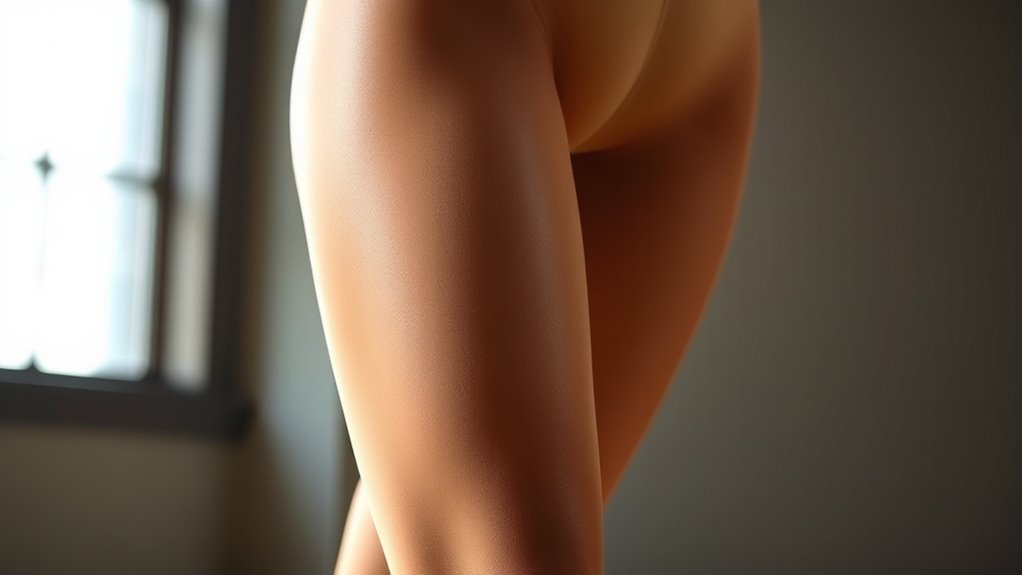
Choosing the right tights shade can make a big difference in how your performance looks. Light skin tones often look best in nude shades that blend seamlessly, while dark skin tones are complemented by deep, rich hues. Knowing which shades work for your skin tone helps you feel confident and polished on stage.
Nude Shades for Light Skin
When selecting nude tights for light skin tones, opting for shades that seamlessly blend with your complexion creates a polished and effortless look. Choosing the right nude shade enhances your stage presence while maintaining comfort. Look for tights that prioritize fabric breathability to keep you cool during performances. The right nude shade also offers style versatility, pairing easily with different costumes and dance styles. To find your perfect match, consider these tips:
- Match tights to your skin’s undertone for a natural appearance
- Prioritize lightweight, breathable fabrics for comfort
- Select shades that complement your costume colors
- Opt for styles that provide a smooth, seamless finish
- Choose versatile shades that can adapt to various dance routines
- Selecting tights made from eco-friendly materials can also contribute to sustainable dance practices. Incorporating environmentally conscious fabrics not only supports sustainability but also enhances comfort and durability in performance wear. Additionally, understanding personal debt forgiveness bills can help dancers better manage their finances, ensuring they can invest in quality stage attire without stress. Staying informed about sustainable fashion options can help dancers make environmentally responsible choices that benefit both their wardrobe and the planet. Furthermore, considering dyeing techniques can help customize shades to match a broader range of skin tones for a more personalized fit.
This approach guarantees you look flawless and feel comfortable, no matter the performance.
Deep Tones for Dark Skin
Deep tones for dark skin enhance your dance look by providing rich, vibrant shades that complement your complexion. Choose tights with a smooth, matte texture to create a seamless blend under your dance costume. Deep browns, chocolates, and espresso shades work beautifully, adding depth without overpowering your overall look. These colors help your movements stand out while maintaining a natural, polished appearance. When selecting tights, prioritize a texture that matches your costume’s fabric for a cohesive finish. Darker tones also minimize any visible contrast, ensuring your skin tone remains harmonious with your tights. By carefully matching these deep shades, you’ll achieve a sleek, professional stage presence that highlights your dance skills and complements your natural beauty.
How to Care for and Maintain Your Dance Tights

Proper care is essential to keep your dance tights in top condition and extend their lifespan. To preserve fabric durability, always follow the washability tips provided by the manufacturer. Hand washing with mild soap is ideal, as it reduces stretching and fabric damage. When machine washing, use a delicate cycle in cold water and place tights in a mesh bag. Avoid fabric softeners and harsh detergents that can weaken fibers. Here are some key tips:
- Wash tights separately from rough fabrics
- Dry flat to prevent stretching
- Avoid wringing or twisting
- Store them folded or rolled
- Replace worn-out tights promptly
Enhancing Your Overall Look With Complementary Accessories
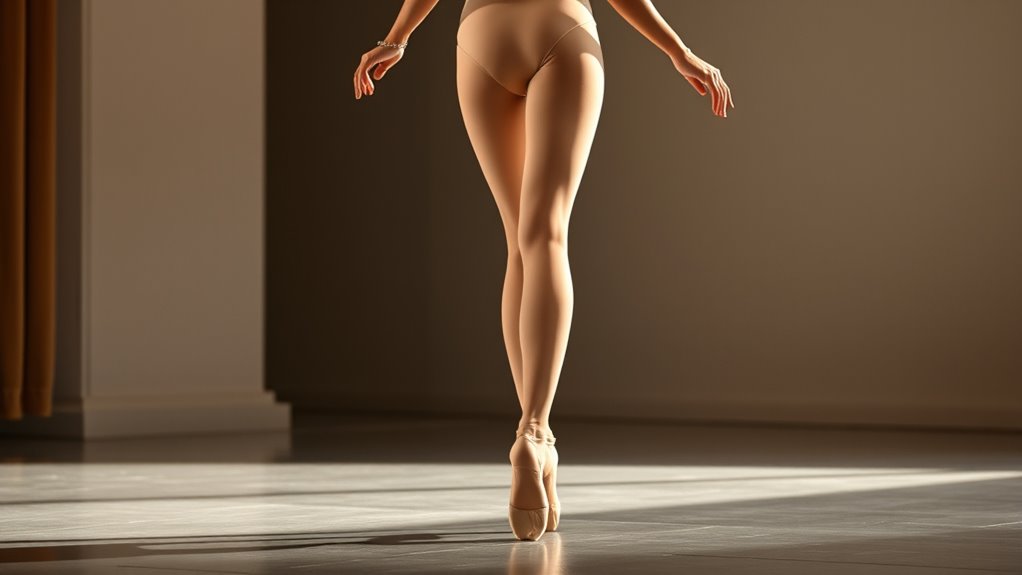
Careful maintenance guarantees your dance tights stay in great shape, but finishing your look with the right accessories can truly elevate your performance. Accessory coordination ensures everything from jewelry to hairpieces complements your tights and costume. Matching your makeup to your skin tone and outfit creates a seamless appearance on stage. Consider these options:
| Accessory Type | Tips for Coordination | Makeup Matching Ideas |
|---|---|---|
| Jewelry | Keep it simple and elegant, matching metal tones | Use natural shades that enhance your features |
| Hair Accessories | Choose colors that complement your tights | Opt for subtle eye makeup to balance your look |
| Belts & Scarves | Match with costume colors or skin tone | Use warm or cool tones to highlight your skin |
| Shoes | Coordinate with tights and costume color | Keep makeup neutral to focus on shoes |
| Props | Select items that enhance your overall look | Use shades that blend with your makeup |
With thoughtful accessory coordination and makeup matching, you’ll complete a polished, stage-ready appearance.
Frequently Asked Questions
How Do I Prevent Tights From Clinging or Sagging During Performance?
To prevent tights from clinging or sagging during your performance, make sure your tights fit well and have enough fabric stretch. Choose tights that are snug but not too tight, as overly tight ones can cause discomfort and sagging. Before your routine, smooth out any wrinkles and double-check the fit. Using a little baby powder or anti-chafe lotion can also help reduce sweating and keep the tights in place throughout your performance.
Are There Breathable Options for Long Rehearsal Days?
For long rehearsal days, breathable fabrics are your best choice to guarantee long rehearsal comfort. Look for tights made from moisture-wicking materials like nylon or spandex blends that allow air circulation and keep you dry. These options help prevent overheating and discomfort, so you can focus on your practice without feeling sticky or restricted. Choosing breathable tights makes a significant difference in maintaining comfort throughout those extended rehearsal sessions.
What Are the Best Brands for Skin-Tone Matching Dance Tights?
They say, “You are what you wear,” and choosing the right dance tights boosts your confidence. For color matching tips, consider brands like Capezio, Bloch, and Danskin, which offer a variety of shades to match your skin tone. These brands are reliable for quality and color selection. When shopping, test different shades against your skin to find the perfect match and feel your best on stage.
How Can I Remove Tights Without Damaging the Fabric?
When removing tights without damaging the fabric, gently loosen them from your toes and work upward, using slow, careful removal techniques. To prevent tearing, consider fabric softening by lightly dampening the tights if they’re too tight or stuck. Avoid pulling sharply, and instead, gently stretch and slide the tights off. This careful approach preserves the fabric and keeps your tights in good condition for future wear.
Can Tights Be Dyed to Better Match My Skin Tone?
You can dye tights to better match your skin tone using simple dyeing techniques. Start with fabric dye suitable for the material, and follow the color matching tips like testing on a small patch first. Keep in mind, dyes may not produce a perfect match, but they can help you get closer. Make sure to rinse thoroughly and follow instructions carefully to avoid damaging the fabric or uneven coloring.
Conclusion
Matching dance tights to your skin tone is like finding the perfect brushstroke for your stage masterpiece. When you choose the right shade, your performance shines brighter, blending seamlessly into the spotlight’s glow. With a little testing and attention, your tights become an extension of your confidence—and your costume’s secret weapon. Embrace the harmony between your skin and your dancewear, and let your stage presence bloom like a vibrant flower in full sunlight.
